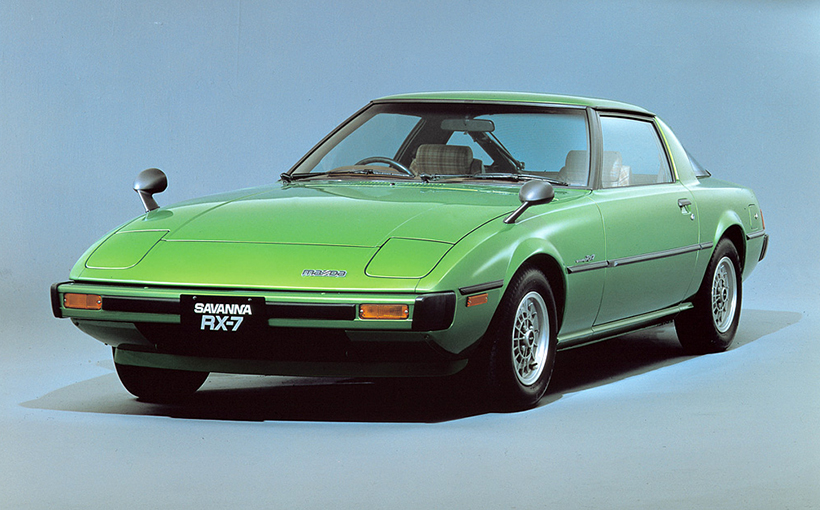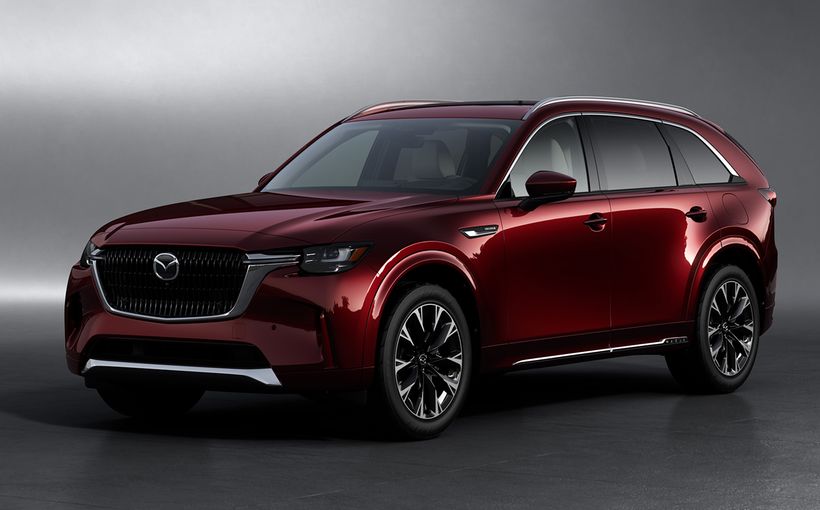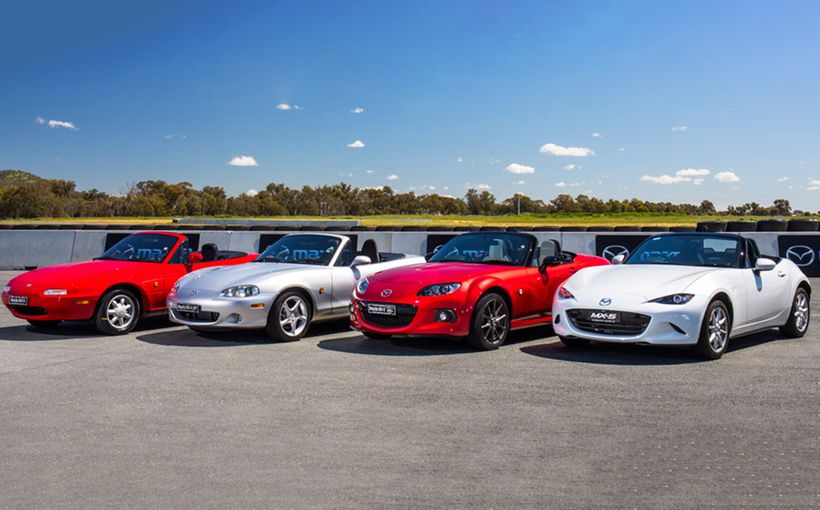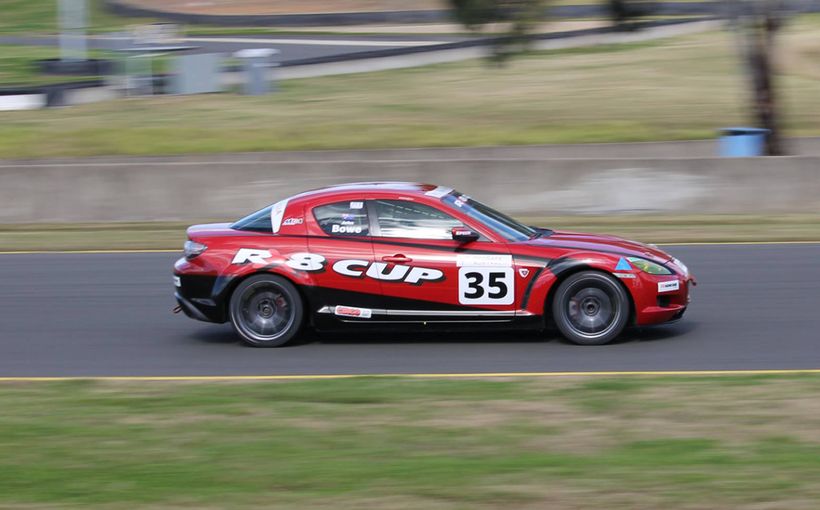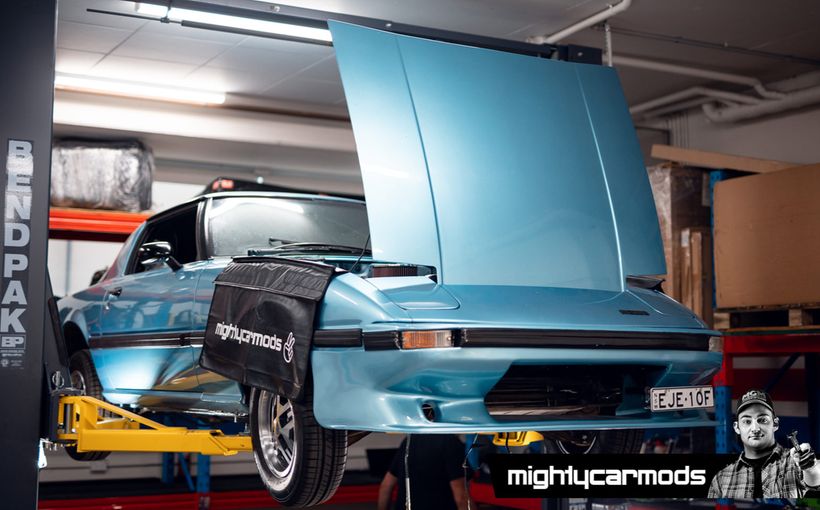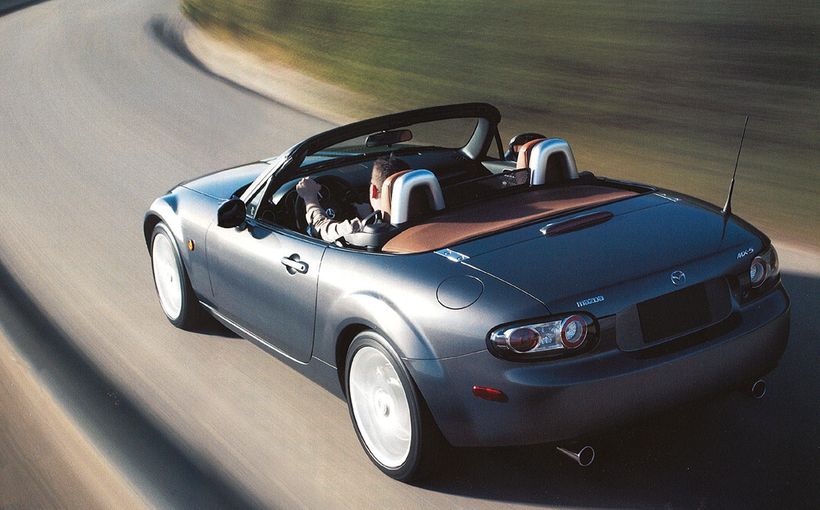1979-85 Mazda RX-7 Series I/II/III: The Banker’s Sports Car

The RX-7’s rotary engine allowed a clean, low-slung wedge closer to a mid-engined model in profile without the luggage and vision issues. It had the fun to drive factor sewn-up yet could still double as every day transport.
1979-85 Mazda RX-7 Series I/II/III: The Banker’s Sports Car
The March 1979 local release of the Mazda RX-7 marked another major Australian milestone only months after the arrival of the VB Commodore. The RX-7 made a top shelf sports coupe experience accessible in much the same way that the Commodore introduced a premium European driving experience to family car buyers.
Although the RX-7’s steep $14,850 price tag was inflated by local tariffs and restricted supplies, it was still half the price of a comparable Porsche 924 and slightly cheaper than a similarly equipped Alfetta GTV 2000. Unlike both of these cars, it was a purpose-designed sports car not compromised by shared mechanicals or platform.
It also marked a clear evolution point for Mazda in Japan and Australia. After the Mazda 1300 was cleverly re-packaged as the first rear drive 323, a more cohesive new 626 replaced the earlier Capella/616. Following these new consistencies in presentation and design, Mazda was ready to cross the threshold into the big league in both the US and Australia.

The rear of the first RX-7 was often described as messy or even baroque by some. Although it was cleaned-up in later models, the early rear remains unusual and escapes the generic look of sports coupes from this era.
To meet this new product-led revival following Mazda’s near death experience during the rotary’s development problems, Mazda’s piecemeal distribution across Australia was a potential stumbling block. Like several Japanese manufacturers in Australia, Mazda distribution in most states was still stuck in the days when local distribution companies were happy to supplement their core business with a handful of oddball Japanese imports.
Australia’s new Mazda range, now headed by a new RX-7 after it was delayed by high global demand, was just the start of what was coming. Although Mazda and other Japanese automotive companies were reluctant to take their franchises away from those Australian companies who helped establish them in the early days, something had to give.
In Mazda’s case, the solution was to establish a new independent Australian marketing arm, Mazda Marketing Services. Headed by Mazda dealer and veteran of numerous Mazda Bathurst campaigns Len Bainbridge, it was responsible for the national marketing on behalf of the different distributors around the country. Although the sales and distribution continued as always, the specifications, marketing, pricing and point of sale material could now be the same. The relationship between those who sold Mazdas in Australia and the Toyo Kogyo parent company in Japan soon occurred at a national level with a national budget.

The RX-7 dash and architecture of the cabin were part of the model’s appeal as they made drivers feel like they were in something far more exotic. The early dash design shown here changed little over the first generation RX-7 model life.
It was a hidden but hugely significant change that would ultimately lead to national head office distribution and change the way that smaller Japanese companies like Suzuki, Honda, Subaru and Mazda would do business in Australia. The same transition was about to occur for boutique European imports such as BMW.
This new structure flourished in the 1979-80 period. Mazda not only generated a more solid profile from sponsoring Australian sporting events on a national level, it could also mount a national factory-backed motor racing campaign compared to the piecemeal dealer-backed efforts of the past. It was an essential perception change to support the much bigger investment that new Mazda models would demand from local buyers.
It couldn’t have happened at a better time as the RX-7 was a potential outright competitor fronting a strong new Mazda range that could benefit from a new national profile underpinned by a serious motorsport campaign. Although the RX-3 had done an amazing job in establishing the rotary, it was still only a development of a budget Mazda model. The RX-7 was ready to go one further and establish Mazda as a leader in other areas.

This X-ray vision highlights why the RX-7 worked so well. Note that most heavy bits are inside the wheelbase. Even the Watts Linkage on the rear suspension was on the forward side of the axle to minimise overhang and weight. (Image from rx7club.com)
Why build an RX-7?
During a period when emissions rules, oil crises and uncertain US legislative requirements threatened the existence of sports cars, Mazda went it alone and created the RX-7. Fortune sometimes favours the brave or the foolhardy. After the first examples were produced in March 1978, the RX-7 was launched in April 1978 in the US and by the time the first body series was withdrawn at the end of July 1985, over 474,565 examples had been produced with 377,878 going to the US. By any standards, it was a huge success.
Australian dates and specifications are unique. Whereas all versions of the first generation RX-7 are grouped together in most markets within that generation, Australians refer to the first generation RX-7 as Series I, II or III, depending on the facelift. The all new second generation RX-7 released in Australia at the start of 1986 is better known as the Series IV locally.
After witnessing the success of the Datsun Fairlady sports in the US, Mazda dabbled with the idea of a purpose-built sports car as early as 1969 using parts from existing Mazdas including the as yet unproven rotary, the baby Mazda ute’s wishbone front end and the Bongo van’s semi-trailing arm rear suspension with various Cosmo (the early rotary coupe) bits to finish it off. Proposed dimensions were similar to the RX-7. As the RX-2 evolved, it made sense to share more parts with the RX-2 until the project was canned in 1970.
It was followed by a large 280ZX/Corvette-style 2+2 coupe concept in 1971 with massive 15A and 21A rotaries to power it. The first major oil crisis in November 1973 killed it in an instant. As an interim measure, Mazda imported Holden HJ-HX Premier bodies in 1975-77 and dropped in the 13B rotary to create the Mazda Roadpacer for a large car entry.

The idea of Holden supplying HJ-HX Premiers to Mazda in 1975-77 to be fitted with 13B rotaries wasn’t as silly as it seemed. The Mazda Roadpacer gave Mazda an entry in the limited civic limousine class with little investment. The Roadpacer looked more at home surrounded by other Mazdas with their quasi-US styling than at Holden. Around 800 were sold but the fuel consumption confirmed that the rotary had no future hauling heavy cars. (Image from hh.hansenits.com)
Although none of these Mazda projects came close to production, they did establish a design language and a list of desirable features. In the meantime, the success of the RX-3 not only prompted the development of a reliable and durable 12A rotary worthy of a sports car, global RX-3 racing programs also taught Mazda a thing or two about handling and suspension tune.
This led to a design study in 1974 based on the RX-3 that exploited a lower centre of gravity and 50:50 weight distribution allowed by the rotary. It was an unauthorized project and its only hope of seeing the light of day was sharing a platform with a rear drive 626 passenger car powered by a piston engine. By rotating the front suspension assembly through 180 degrees, the wheelbase could be varied by five inches/101.6mm without altering the floor pan.

Mazda took a close look at sports models on sale in the US including this Triumph TR7 which had benchmark body stiffness. The Triumph TR7 had a high scuttle dictated by its piston engine. Its short wheelbase and overhangs meant it wasn’t the prettiest contender but it was seen as daring at the time. (Image from listadecarros.com)
It was a good idea but still a compromise. Then the unthinkable happened. The post-November 1973 oil shocks hit Mazda and its rotary engine brutally with stocks of unsold rotary models banking up at a massive rate globally. Because the rotary had soaked up so much of Mazda’s brightest human and financial resources, Mazda didn’t have a fallback position. The company was forced to send company engineers and designers to Japanese dealers to help clear the stock and generate funds. It was a desperate measure with no long term outlook. Had it succeeded, an unprecedented market focus in the factory culture was a potential benefit.
The normal reaction of a Japanese bank would have been to wind the company up when the outlook was so bleak. Yet Mazda’s bankers, the Sumitomo Bank, recognized that Mazda was on the brink of exploiting its hard-won rotary engine development.
The hurried revitalizing of Mazda’s piston-engined models led by the original and successful rear drive 323 (GLC elsewhere) Hatchback, gave Sumitomo and Mazda a financial cushion. It was time to revisit the sports car.

Until Mazda engineers and designers agreed to make the RX-7 headlights retractable, the bug-eyed early RX-7 prototypes looked very similar to this British TVR. Because the TVR was not a mainstream model and had a cottage industry feel about it, Mazda did well to avoid any resemblance. (Image from photogallery.classic cars.com)
The Banker’s Sports Car
Just as Michelin gave Citroen the human resources and financial leadership to allow its engineers to carry on with the new DS without disruption, the Sumitomo Bank did the same for Mazda. As soon as the Sumitomo board appointed one of their bankers as Mazda’s marketing executive, he immediately toured the company’s US operations in 1975. He came back convinced that Mazda needed to produce a small rotary-powered sports car.
His conclusion was shared by Mazda’s engineering team who had witnessed the growing popularity of the RX-3 amongst young Japanese on and off the track. They were equally convinced that the domestic market would also generate strong volumes. Yet it was the Sumitomo banker, Sinpei Hanaoka, who shocked his board by advocating such a frivolous project in those uncertain “oil-shock” times.
After the rotary had evolved and proved unsuitable for larger passenger car duty (this was being demonstrated starkly in the rotary-powered Holden HJ- HX Premier still on sale as the Mazda Roadpacer) or light commercials, Mazda had no choice but to exploit the rotary’s finer points in a context that suited it. It was a compelling argument backed by the earlier engineering studies.

Mazda is often accused of shadowing the Porsche 924 but they have nothing in common. Porsche used the same wedge reference points as Mazda and came up with its own take on the theme. The 924 was a bigger and taller personal coupe and in standard form was not as sporty as the RX-7. (Image from seriouswheels.com)
The outcome in mid-1976 was to drop the shared platform approach and let the new 626 proceed without compromise as the next generation project X606 passenger car that surfaced as the new 626 2.0-litre in Australia. New packaging and engineering levels won immediate acceptance. However, careful links in the styling and colours would ensure a perceived link remained between the two projects.
The sports car project went back to scratch with its own platform and was redefined in isolation as project X605 under star Mazda engineer and former president Kohei Matsuda. It was at moments like these that the long term stability of Japanese companies and their workforces gave them an edge. The collective knowledge from previous concepts and proposals was already there to determine exactly how the RX-7 needed to take shape. The first prototype was completed by the start of 1977!
The RX-7 Brief
The new car had to have an “international flavour”. It also had to be affordable (under $US7000), light and tough. Mazda had assessed the mid-engined Porsche 914, Fiat X1/9 and the Triumph TR7. Although starting to age, the Datsun 240/260Z was still a formidable rival.
Along the way, the Porsche 924 emerged, a car initially intended as a Volkswagen, powered by the old Audi engine, also used in light commercials. Its rear transaxle and suspension were lifted from the VW Superbug and there was more than a few VW Golf parts spread throughout the cabin. In the US, it was priced at $US12,000.

It frustrated Mazda that there wasn’t the time to develop a large one-piece glass liftback like the Porsche even if the hidden rear side window supports in the RX-7 cut weight and boosted stiffness. (Image from seriouswheels.com)
The RX-7 is often described as a Japanese clone of the 924 but the two cars couldn’t be more different in design approach. The time frame for this to have happened doesn’t fit anyway. The 924 was a VW parts bin special developed by Porsche for VW’s US network as a 914 replacement except Volkswagen changed its mind so it could focus on its switch to front drive. Porsche, also faced with a switch from rear engine, rear drive, took on the production-ready 924 to test the waters for its own front engine range.
The RX-7 shape, styled internally by Mazda, was an amalgam of all the latest wedges with two fundamental differences. As a purpose-designed rotary model, its engine could be mounted way back in the chassis and the wedge shape was not a wedge door-stop attached to the end of a high scuttle and bonnet line.
Fundamental to the RX-7’s appeal was the low sports car seating position matched to an equally low glass line. The low scuttle height generated by the compact rotary engine gave it a similar feel to the mid-engined Fiat X1/9 and the Lotus Esprit from the driver’s seat. It had an open and airy cockpit feel conducive to everyday usage. Unlike the Lotus Esprit and earlier Europa wedges, it had good rear vision and some luggage capacity. The piston engines of its front engined rivals dictated a higher scuttle and very different architecture for their cabins.

The Series II upgrade brought modest power and torque increases along with a cut in Cd from 0.36 to 0.34, equivalent to a five bhp increase. Although the RX-7 was now smoother to look at, it wasn’t as quirky as the Series I.
There were two stumbling blocks. The initial concept dictated bug-eyed open headlights which gave it an old school look reminiscent of the Lotus Europa and TVRs of that era, not the right association for a top-shelf latest technology Mazda model. The RX-7’s low profile wedge made minimum headlight height requirements a nightmare. As agreement was reached between engineers and designers in terms of weight and simplicity, the “bug eyes” were replaced by an unusually reliable headlight retraction system.

Later cars had different instrument graphics and extra instruments but otherwise the cabin continued with little change until the end. (Image from quicksales.com.au)
The other challenge was to offer rear liftback luggage access while maintaining lightness and body strength. The preferred large one-piece wraparound glass liftback similar to the Porsche 924 was rejected. It came with a big cost and weight premium as it dictated extra lower body strengthening with such a large hole at the rear to maintain Mazda’s target body stiffness.
Because Mazda was committed internally to provide the best possible showcase for the rotary with competitive fuel consumption and off the mark acceleration, unnecessary weight was not an option. One of the biggest complaints that would face the second generation/Series IV RX-7 which would later feature this one-piece rear glass was its extra weight.
Mazda’s solution to this rear glass issue in the first generation RX-7 contributed significantly to the outstanding 1065kg kerb weight and the amazing torsional body stiffness. Although the external effect was similar to a one-piece wraparound rear glass, there were two internal support struts from roof to lower body that supported two fixed side windows.

The ultimate first generation RX-7 sold in Australia was the Series III Limited with optional two-tone paint and sunroof. Because of Australia’s oddball emissions laws, the carburettor 12A rotary was the sole engine choice from start to finish but at least it was mounted in the right place for 51:49 weight distribution. (Image from carsales.com.au)
This not only reduced potential sealing problems and kept the rear glass clear of a rear impact, it also allowed the distinctive single centre-pillar styling. Both the Porsche 924 and Datsun 260Z/280ZX had extra side windows supported by B- and C-pillars. The RX-7 was one of the first Japanese models of its type to chart its own direction in so many areas.
If anything, the RX-7 rear glass and the fat centre pillar added to the tough, purposeful look, an impression backed up by the 9200Nm per degree torsional stiffness figure, just under the benchmark TR7 figure of 10,000 and well clear of the Datsun 280ZX’s 7300. Because the TR7 was a three-box style on a much shorter wheelbase with an unusually short cabin and thick pillars, fixed rear glass, fixed rear seat and a relatively small boot opening, the RX-7 figure was quite an achievement. It was backed up by a Cd of 0.36, the same as the 924.
Size and weight remained commendably tight. Conceived as a 2+2, the occasional rear seat which folded, had to be deleted in the US to make space for lower frame extensions to pass US rear collision requirements. It spared the US RX-7 from gratuitous local criticism that took delight in pointing out the rear seat was next to useless, no less than what you would expect of a compact sports car. As back-up short term seating for children or a single adult, it remained an important local selling point.
The RX-7 was based on a 2420mm/95.3in wheelbase with 1420/1400mm front and rear tracks (55.9/55.1in) and a length of 4285mm. The 1650mm was well under the Japanese 1700mm limit and it was only 1260mm high or 49.6in. Weight varied from 1065 to 1080kg with the Australian version’s standard five speed manual generating a 1070kg figure.

Note engine mounted well back in the chassis and low scuttle height. Front coils were wound in a tighter cone at the base to allow optimum steering geometry. (Image from ranwhenparked.net)
Chassis Development
The single biggest factor that transformed the RX-7 under the bonnet and on the road was the RX-3 and lessons it delivered on the track.
Mazda neither had the time nor could afford the risk of unleashing another round of unproven technology. Again, as the banker’s sports car, it had to exploit what was already proven which later proved to be the key to the RX-7’s success. Like the VB Commodore and the Rover SD1, both of which had much in common with the RX-7 approach, it was the exhaustive refinement of the conventional.
Up front were proven MacPherson struts but with a twist. The coil springs were concentric to the strut and wound in a cone shape at the base to provide extra internal clearance for both wheel and tyre. Why? Mazda was chasing the same centre-point steering geometry so critical to the Citroen DS and exploited by Volkswagen and Audi in their latest front drive models. Although the geometry was not as pure as some applications, the RX-7’s steering offset was commendably small at 38mm or 1.5 in.
For a budget sports coupe, the RX-7 was unusually stable under brakes and changes of road surface. Steering vibrations and kickback were minimized. Yet it was in this area that the RX-7 copped most of its criticism.
Instead of installing the traditionalist sports car’s rack and pinion steering, Mazda stuck with its proven recirculating ball system on account of cost, space and the limited development time. Although this system’s isolation of road shock and low effort were consistent with its US target market, it would normally have destroyed RX-7 credibility if it wasn’t for key RX-3 racing developments.
According to figures at the time which quantified the more direct and superior feel of rack and pinion steering , a representative rack and pinion system distorted 7-16 degrees as soon as 1 kg-m of torque was applied at the steering wheel. The RX-3 system distorted 19-33 degrees, an unacceptable figure for the RX-7.
The solution was to boost the RX-3’s steering shaft from 25.5 to 33mm diameter and relocate its support bearings. This dropped the distortion back to 15 degrees, within the zone of the worst rack and pinion set-ups, enough to make the RX-7 acceptable. Yet it was not enough to counter the recurring criticism of the vague or sloppy feeling at straight ahead.
The steering shortfalls stood out against the unusually balanced handling (weight distribution was 51:49 front to rear) and tenacious grip generated by the live axle rear end. Again, it reflected RX-3 factory racing development. Suspended on coil springs with gas dampers, it featured upper and lower trailing arm location. The clever part was the Watts Linkage anchored on the forward side of the axle, offset to the right of the differential housing. Compared to a Panhard rod (as used in the VB Commodore), it reduced the roll centre and cut the length of the RX-7 by 3 inches/76mm with the resulting cut in weight.

Local RX-7 Series II/III deliveries had their number plates mounted between the tail lights, elsewhere they sat under the rear bumper. This shot not only highlights how Mazda made the RX-7 bodyshell unusually stiff but the airy cabin feel was unusual for such a small sports coupe. (Image from carsales.com.au)
Initially, brakes were kept to a proven front disc (226mm/8.9 inch)/rear drum (200mm/7.9 in) set-up with 13 inch wheels. In Australia, the wheels were initially 5.5 inch alloys with 185/70HR13 Bridgestone RD106 radials, adequate but nothing exceptional.
The icing on the cake was the standard anti-roll bars; 23mm at the front and 18mm at the rear. They were an option on the Porsche 924 and gave the RX-7 an edge in most comparisons.

Before Australia switched to unleaded fuel in 1986, local emissions requirements were a nightmare when they didn’t align with other markets. The plumbing in any first generation RX-7 engine meant that the engine bay was not something you would show off to your friends. (Image from carsales.com.au)
The Drivetrain
The carryover RX-3 12A rotary was given a modest power and torque boost depending on market. The big development was a new chrome-plating process applied to the trochoidal surface or the inner chambers. This new coating with its pinpoint pores trapped oil and cut wear at the rotor tip seals dramatically.
It also allowed the rotor seals to be manufactured from metal instead of carbon, aiding thermal efficiency as well as wear resistance.
It worked, as many Australian RX-7 owners would soon clock-up as many as 300,000km trouble-free kilometres.
It was fed by a single downdraught four barrel carburettor that opened in two stages. Each rotor (there were two) had a leading and trailing spark plug of the latest three-electrode design. There were two side intake ports and one peripheral exhaust port per chamber.
Local output figures, which were specific to the 12A engine adapted for local leaded fuel were initially 77.2kW@6000rm and 147Nm@4000rpm. Modest boosts for the 1981 Series II upgrade pushed this out to 84.6kW and 152Nm at the same revs.
Mazda kept the powerful 12A Turbo version close to home for the first generation RX-7 in case there were development issues. The real sleeper was the US market Series III 13B rotary which was very close to the Australian Series IV 13B in specification and just 9kW short of the Series IV output in a far lighter body. In a local 1984-85 Series III Limited, it would have set a new benchmark but under Australia's oddball emissions regs based on leaded fuel, it couldn't be offered here.
Although four and five speed manuals were offered, Australia saw only the five speed which featured the same ratios as the four speed with the addition of a 0.825:1 fifth ratio. A Jatco automatic was developed as an RX-7 option but remained a three speed in Australia until the end of the Series III.

Towards the end, the local RX-7 was criticised for its patchy dash layout as more items were added. For the US Series III upgrade late in 1983, the RX-7 was given a new dash layout that previewed what was coming in the Series IV. (Image from dailyturismo.com)
Local Production History
There were three clear variations of the first generation Mazda RX-7 sold in Australia:
RX-7 Series I Super Deluxe-Built February 1979 to October 1980
These cars had the original separate bumper style with end caps, recessed number plate panel between the plain horizontal tail lights and fine-spoked alloy wheel style.
Other distinguishing points include wind-up door windows, a gear lever closer to the dash and a tacho needle which becomes the voltmeter when the ignition is switched on then returns to tacho as soon as the engine is running. Other gauges were clock, temperature and fuel. Headlight and wiper switches were specific to Series I.
Running changes in 1980 improved the trim.
RX-7 Series II Super Deluxe-Built November 1980 to September 1983
Big improvement in aerodynamics dropped CD to 0.34 with integrated bumpers front and rear. Front end lift reduced significantly. Rear disc brakes replaced drums. A less aggressive 16mm rear anti-roll bar resulted in more progressive handling.
Rear styling now featured flush tail lights with horizontal lines separated by a matching flush panel and number plate relocated level with the tail lights. Chunkier four-spoked alloy wheel style but they were still 13 inch. Fatter side strips lined-up with bumper inserts.
Local cars missed the heavily-revised US dash but dash revisions included an oil pressure gauge, revised specific voltmeter inside tacho, quartz clock in the console and new instrument graphics. A shortened gear lever was moved closer to driver. Seats gained extra contouring and there was a remote release for the fuel filler. Rear wiper, electric windows and electric mirror adjustment were also added.
Engine output was lifted from 77.2 to 84.6kW, torque from 147 to 152Nm.

Although this Australian Series III Limited cabin still seemed sporty enough in 1985, the US dash in the photo above was a quantum leap forward. Mazda couldn’t afford US RX-7 sales to dip against tough new opposition while preparing the Series IV. Note the vision and glass area which made the RX-7 such a popular all rounder. (Image from carsales.com.au)
RX-7 Series III Limited, Deluxe, Sports-Built October 1983 to December 1985
Similar to Series II with new Limited model that featured side repeater lights in the side strips ahead of the front wheel arches, eight vertical slots in the front spoiler on each side, 12-spoked 14 inch alloys from 929 Luxury, twin-jet windscreen washers, optional two tone-paint.
Four wheel ventilated disc brakes with new wheel stud pattern, bigger fuel tank with space saver spare and more sound deadening were also listed. Look for the three spoke steering wheel, graphic equalizer digital sound system with joystick control and cloth headlining.
A new Sports level featured wraparound black rear spoiler, steel slotted wheels, wind-up windows, vinyl trim, early one-piece tombstone seat backs, deleted rear wiper and moulded steering wheel for motorsport. Downgrades were in areas most likely to be replaced or surplus to racing.
A new Deluxe level looked similar to the Sports minus the rear spoiler but came with cloth seats, air-conditioning, the three-spoke leather steering wheel, velour trim and basic AM/FM radio.

Australia was still a year or two from the full aero look which might explain why this Mirage RX-7 looks like aero wedge meets L34 Torana.
Special Local RX-7 Models
Mirage: Based on the Series I, the late 1979 Mirage limited edition of 20 examples in Sunrise red only with black stripes was part of the build-up for a local RX-7 racing campaign. Some estimates suggest 25-26 were built. Based on the white with blue stripe Penfold Motors motor show car (Penfolds often carried out work for the Melbourne-based Mazda Marketing Services) prepared by Peter Arcadipane (former Holden and Ford designer), it featured a body kit that included a centre bonnet scoop, large rear tray spoiler, wheel arch flares and front air dam. Aunger 7 inch Hotwire alloy wheels were fitted with 60 series Dunlop SP Sports tyres and a Goodrich space saver to maintain boot space. Inside, the air-conditioning, radio-cassette, clock and velour trim were deleted. Plain vinyl trim and a gear lever extension were further cabin differences. The deletion of the big dollar features left an overall price lower than the mainstream RX-7 Series I.
Allan Moffat Special: In August 1980, 10 examples based on the Series I came with front and rear spoilers, glass sun port, Mazda RX-7 rear reflector panel and AMS badging.
Gregg Hansford Special: In early 1984, Gregg Hansford and City Mazda Brisbane teamed up to offer a limited edition based on Series II/III with front air dam, rear wing, Compomotive alloy wheels, driving lights and upgraded suspension with Bilstein dampers.
Finale: Based on Series III, this was a limited edition clearance model offered in some states at the end of 1985 to clear the final Series III examples.

The ultimate RX-7 was the Japanese market 12A Turbo but this Series III GSL SE sold in the US was the better all round choice. Although not quite engine bay eye-candy, the bigger 13B rotary with six-port induction, Dynamic Effect Intake system and electronic fuel injection was much more credible. Power went up to 101kW, enough to cut the standing quarter time back to 16.2 seconds. (Image from dailyturismo.com)
How Did it Compare?
The Mazda RX-7 was first pitched by Wheels against its local opposition in October 1979. Rivals included the $15,000 Alfetta GTV 2000, the $19,000 Datsun 280ZX and $27,146 Porsche 924. Significantly, both the Alfa and Porsche resorted to similar front engine-rear transaxle layouts to achieve better weight distribution on the same 2400mm wheelbase.
The verdict? With a standing 400m of 17.4 seconds, the RX-7 was quicker than the Alfa, on par with the 280ZX and slightly slower than the 924 (17.0). In most acceleration tests, it was equal to the best and the fastest in the zero to 110km/h dash with a figure of 11.4 seconds compared to 13.6, 13.8 and 12.5 for the Alfa, 280ZX and Porsche 924. That lead stretched even further in the zero to 130km/h sprint but the 181km/h top speed was slower than all three. The RX-7 was clearly set-up to perform at its best under local speed limits compared to the more frugal and long-legged 924.
More importantly, the RX-7 didn’t post the worst fuel consumption. That honour went to the 280ZX but the Porsche 924 was exceptional in this respect (RX-7’s 20.9 versus the 924’s 25.9mpg average).
The Wheels conclusion? “So the Mazda wins. It has an engine that sings songs on high and can’t be fully appreciated until you climb from behind the wheel of a conventionally-powered car – any conventionally-powered car – and discover just how easily, how smoothly it does things. No, it won’t carry four adults the way the Alfa will, it is too much a two seater sports car for that and the steering is disappointing, the brakes can be made to fade but it comes together brilliantly and despite a high price in Australia, it must be considered as good value.”
As a first-up entry at this level, it was a brilliant result echoed in the US and explains why the initial production rate of 5000 per month had to escalate to 9000 a month for the RX-7 to even reach Australia.

Spiralling currency issues in 1985 pushed the RX-7’s price tag into luxury coupe territory hence a weight penalty from the extra gear. Even in a plain colour, this late model Limited still looked as sharp as the original in 1979. (Image from ausrotary.com)
By September 1984, it was approaching the end of its model life when Wheels pitched the Series III against the Nissan 300ZX, Mitsubishi Starion, Alfa Romeo GTV6 and the first Toyota Supra.
Although RX-7 performance had improved, its 17.0 second standing 400m was only faster than the Supra which had been nobbled locally with its Cressida single-cam 2.8-litre engine. The rest were comfortably in the 16s with the Starion as the new sprint leader. The RX-7’s zero to 100km/h sprint of 12 seconds was not the worst and as good as most rivals except the Starion again set the benchmark with its 10.5 second figure.
Yet in this company, the RX-7 posted the best fuel consumption by a reasonable margin, suggesting that the 1979 RX-7’s higher fuel consumption relative to rivals was only reflecting its equally faster performance.
The verdict? “Mazda is (the) most sporting of test cars, although it is burdened with too many unnecessary luxury extras and switchgear placement is haphazard. Steering and ride are lacking but RX-7 has (the) best chassis and balance, on smooth roads.”
The real culprit here was the rapidly changing Australian economy which had pushed the RX-7 price up to $22,660, much cheaper than the Alfa’s $29,700, the 300ZX’s $26,500 and the Supra’s $26,200 but closer to the Starion’s $23,862.
At the end, Mazda was forced to re-position its top RX-7 at the new Series III Limited level to justify the price hike and its advancing years. It could no longer be judged as a cheap and simple sports car, but one that had to be repackaged as a luxury coupe. Ironically, the RX-7 Limited featured equipment levels now regarded as essential.

The RX-7 Series III GSL SE with US impact bumpers that prevented the rear seat from being fitted to make room for their mounting points. Note the different tail panel detailing on US cars. (Image from dailyturismo.com)
Many of its extra items were not available in the others, something not lost on buyers. Items such as cruise control, premium sound system and full electrics (windows, mirrors, fuel filler, hatch release, headlight washers, rear wiper, sunroof) were still judged in 1984 as getting in the way of genuine sports car motoring.
On that score, Wheels ultimately rated the Starion as defining the best balance between luxury and sports coupe: “the Starion is consistently the fastest and most relaxing (steering apart) over long stretches of Australian territory.” Wheels then qualified this win by suggesting that buyers had to be prepared to live without the extra luxury equipment standard in the RX-7.
This summed up the reign of the first RX-7. It was so good that it didn’t allow clear cut victories even at the end. And that final Series III was about to prove to be a massive headache to replace.
Reference: The New Mazda RX-7 and Mazda Rotary Engine Sports Cars by Jack Yamaguchi

